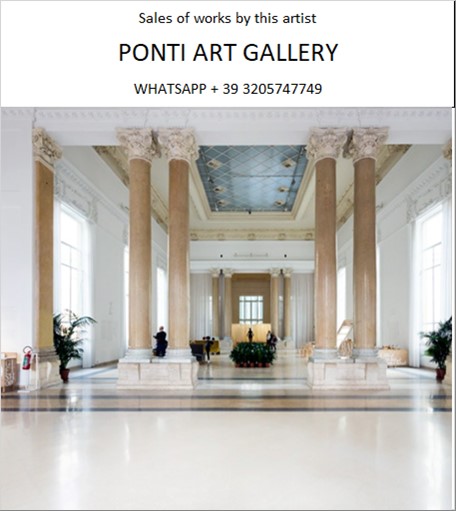Ponti Art Gallery is interested in buying and selling works
of art by this artist.

Kei Hiraga Biography
Kei Hiraga was a Japanese artist whose work left a significant mark on the landscape of Asian Modern & Contemporary art. Born in Tokyo in 1936, Hiraga's life and career were shaped by the cultural and historical milieu of post-war Japan, a period marked by reconstruction and cultural renaissance.
Raised by his aunt in Morioka, Hiraga was exposed to a world of traditional Japanese aesthetics from an early age. His aunt's restaurant, frequented by Geishas, provided a vibrant backdrop that would later influence his artistic vision. Despite graduating from Tokyo University in 1958 with a degree in Economical Sciences, Hiraga's passion for art led him to pursue a career in painting, aligning himself with the International Spirit of Nonconformist 'Litterati' painters. This group, which included artists like Cormery and Zhu Xinjian, was characterized by a rejection of moral hypocrisy and a dedication to the mastery of painting, life enjoyment, and sexual ecstasy.
The aftermath of the Atomic Bomb on Hiroshima had a profound impact on Hiraga and his contemporaries, who came to be known as the Buraiha or the 'school of irresponsibility and decadence.' This post-war nihilist movement, also referred to as the 'decadents' of Japan, was a reaction against pre-war literary and pictorial traditions as well as the American values imposed during the post-war occupation. The Buraiha lifestyle was provocative, marked by drunkenness, drug use, and a hectic free sex life, often culminating in suicide, which they considered another heroic choice.
Hiraga's early work was recognized in 1964 when he was awarded the 'New Artist Prize' at the National Exhibition in Tokyo Metropolitan Museum. His talent caught the attention of curator William Lieberman, which led to Hiraga's inclusion in the Museum of Modern Art's collection in New York. His work was featured in the 'New Japanese Painting and Sculpture' exhibition, which toured various museums in the United States between 1965 and 1967.
In his art, Hiraga combined ancestral Japanese techniques, such as the art of tattooing on GI's flesh in a Tattoo parlor, with oil painting. He drew inspiration from Theatre Nô and infused his work with a psychedelic spirit, humorously unveiling the Human Comedy with its sexual dreams and obsessions. His canvases were a unique blend of traditional Japanese art and the psychedelic culture that emerged in the 1950s and 1960s.
The 1970s saw Hiraga move to Paris, where he immersed himself in the bohemian art scene. This period was transformative for his style, as he began to incorporate a European flair into his work. His experiences in Paris, living among artists and gallerists, influenced his thematic explorations of eating, tea ceremonies, and swimming, as seen in works like 'Feast' and 'Oiso Long Beach.' These pieces depicted personally significant themes with a European twist, showcasing Hiraga's ability to blend Eastern and Western influences seamlessly.
Hiraga's compositions from this era were audacious and visually electric, reflecting his fascination with French culture and his own chaotic yet exhilarating life in France. He experimented with acrylic paints, which allowed him to articulate his newfound confidence as an artist. His vibrant color palette and eccentric, sexually entangled figures demonstrated his understanding of the importance of figurative narrative, drawing inspiration from sources such as Alfred Hitchcock's movie 'Rear Window,' comic strips, and Picasso's 'Guernica.'
Upon his return to Japan in the 1980s, Hiraga sought to create works with a greater Japanese flavor, having mentally prepared to do so for years. His careful use of gold color in his paintings is reminiscent of Japan's famed gold screens, evoking nostalgia for the artistic heritage of his homeland. His works from this period, such as 'Endless Evening' and 'Room with an Ocean View,' display an equilibrium of Eastern and Western influences, with a repetitive yet carefully executed palette of non-representational colors, forms, and proportions.
Kei Hiraga's legacy is one of a unique and complex artist who navigated the cultural crosscurrents of his time with humor and skill. His work is a testament to his life's journey, from the traditional settings of his youth to the vibrant art scene of Paris and back to his roots in Japan. His art continues to captivate audiences with its playful reinventions and candid autobiographical details, remaining fresh and relevant to this day. Hiraga passed away in 2000, leaving behind a body of work that continues to be celebrated and studied for its distinctive contribution to modern and contemporary art.
Kei Hiraga Quotes and Sales of
Works
Ponti Art Gallery selects and deals with paintings by the
artist. Upon request, we provide free estimates and
evaluations, communicate prices, quotations, and current
market values.
If you are interested in BUYING or SELLING works by the
artist, contact us immediately.
If you wish to sell or receive an evaluation of the
works:
Send us a frontal photo of the painting, one of the back,
and one of the signature. Also, indicate the dimensions of
the work. Inform us about the purchase origin of the work
and any kind of available documentation (purchase
receipts, certificates of authenticity, publications). One
of our operators will respond to you on the same day. We
guarantee maximum confidentiality and extreme
professionalism.
If you wish to purchase works by the painter: Contact us
and let us know your request. We will inform you about the
available works. We also offer the possibility to
subscribe to our NEWSLETTER, through which you will be
informed at the beginning of each month about the latest
acquisitions of the art gallery.
You can send us pictures of the work:
